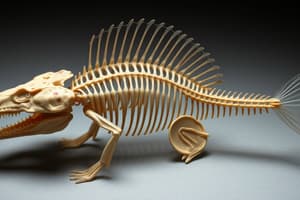Podcast
Questions and Answers
What is the primary function of the notochord in chordates?
What is the primary function of the notochord in chordates?
- Provides structural support in the embryonic stage (correct)
- Protects the central nervous system
- Becomes the spinal cord and brain in vertebrates
- Serves as a primary support element in the adult stage
Which characteristic of chordates is eventually replaced by the vertebral column in vertebrates?
Which characteristic of chordates is eventually replaced by the vertebral column in vertebrates?
- Dorsal hollow nerve cord
- Pharyngeal slits
- Post-anal tail
- Notochord (correct)
The dorsal hollow nerve cord in chordates develops into which structures in vertebrates?
The dorsal hollow nerve cord in chordates develops into which structures in vertebrates?
- Spinal cord and brain (correct)
- Pharyngeal slits
- Heart and lungs
- Post-anal tail
What differentiates vertebrates from other chordates?
What differentiates vertebrates from other chordates?
Which class of vertebrates is known to live exclusively in aquatic environments?
Which class of vertebrates is known to live exclusively in aquatic environments?
What is a key characteristic of mammals?
What is a key characteristic of mammals?
Which group of vertebrates is known for having feathers and wings?
Which group of vertebrates is known for having feathers and wings?
What is a defining feature of reptiles?
What is a defining feature of reptiles?
Which vertebrates have played a crucial role in the evolution of complex organisms according to the text?
Which vertebrates have played a crucial role in the evolution of complex organisms according to the text?
What adaptation has enabled birds to fly or glide?
What adaptation has enabled birds to fly or glide?
Flashcards are hidden until you start studying
Study Notes
Phylum Chordata: A Deeper Look at Vertebrates
The phylum Chordata is a diverse group of animals, encompassing a wide range of organisms, including vertebrates and a few invertebrate species. In this article, we'll delve into the fascinating world of chordates, focusing specifically on vertebrates, the subgroup that is more familiar to us due to their direct impact on our daily lives.
Chordate Characteristics
All chordates share a set of common characteristics:
- Notochord: A flexible, rod-like structure that serves as a primary support element in the embryonic stage and is present in some adult invertebrate chordates. In vertebrates, the notochord is replaced by the vertebral column.
- Dorsal hollow nerve cord: A tubular structure that eventually becomes the spinal cord and brain in vertebrates.
- Pharyngeal slits/gill slits: Openings that allow water to flow through the pharynx used for feeding and respiration in larval stages, eventually disappearing in adults.
- Post-anal tail: A tail-like structure present in some larval forms.
Vertebrates
Vertebrates are chordates that possess a backbone or vertebral column, which provides structural support and protection to the central nervous system. There are five classes of vertebrates, each with its unique characteristics and adaptations:
- Fish (Pisces): The most ancient vertebrate class, fish live exclusively in aquatic environments. Some notable examples include goldfish, salmon, and sharks.
- Amphibians (Amphibia): Amphibians start their lives in water but complete their development on land. Examples include frogs, toads, and salamanders.
- Reptiles (Reptilia): Reptiles are ectothermic vertebrates that inhabit a wide range of environments and can be found on land, sea, and air. Examples include snakes, turtles, and lizards.
- Birds (Aves): Birds are endothermic vertebrates with feathers and wings, enabling them to fly or glide. Examples include sparrows, eagles, and penguins.
- Mammals (Mammalia): Mammals are warm-blooded vertebrates with hair or fur, mammary glands, and a neocortex in their brains. Examples include humans, lions, and whales.
Evolutionary Importance
The phylum Chordata and its subgroup, vertebrates, have played a crucial role in the evolution of complex organisms, particularly through the development of adaptations that have allowed them to occupy diverse ecological niches. Vertebrates have been responsible for some of the most significant innovations in animal history, including the evolution of sensory organs, complex brains, and sophisticated locomotor systems, which have led to the emergence of human civilization.
Applications in Modern Science
Understanding the structure and development of chordates has led to numerous applications in modern science. For instance, knowledge of the vertebrate nervous system has been instrumental in the development of neuroscience, while the study of chordate embryology has provided insights into the fundamental processes of organismal development. Additionally, the evolutionary relationships among chordates and their relatives have been crucial in understanding the origins of the human lineage and the development of a wide range of agricultural and medical technologies.
Conclusion
In summary, the phylum Chordata and its subgroup, vertebrates, have been pivotal in the evolution of complex organisms, providing a rich tapestry of adaptations and innovations that continue to shape our understanding of the natural world. Vertebrates serve as model organisms for studying biological processes and have practical applications in numerous fields, including medicine, agriculture, and environmental science. The next time you observe a fish swimming in the aquarium or a bird soaring through the sky, remember that you are witnessing an evolutionary success story that has spanned over half a billion years.
Studying That Suits You
Use AI to generate personalized quizzes and flashcards to suit your learning preferences.




